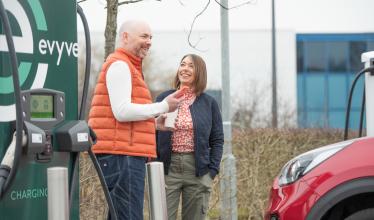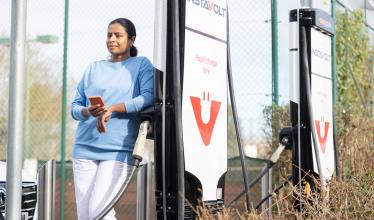British adventurer and Guinness World Record holder Chris Ramsey has set himself a big goal. He’s planning to become the first person to drive from Pole to Pole.
But that’s not all. The marathon expedition also aims to raise awareness of climate change – and to highlight the role that electric cars can play in reducing our carbon footprint.
If Ramsey succeeds, it will be the first time that any vehicle – electric or otherwise – has driven from the South Pole to the magnetic North Pole. Whatever the outcome, it’s certainly a fantastic way to highlight exactly what electric vehicles are capable of, and in some of the most extreme climates on Earth.
The Pole to Pole Expedition
The expedition itself is scheduled to start in late 2022, after nearly four years of planning. It will cover 17,000 miles across 14 countries, as the team make their way from the South Pole to the finish line at magnetic North.
This won’t be Ramsey’s first expedition in an electric vehicle (EV). In fact, he’s has been adventuring in EVs for over a decade. And in 2017, Ramsey and his wife Julie became the first team to complete the Mongol Rally in an EV, travelling over 10,000 miles through 20 countries in 56 days, driving from Goodwood Racing Circuit in the UK to Siberia.
Ramsey certainly looks the part. He wears a robust coat from The North Face, a determined expression and an adventurer’s stubble. But despite all his experience, is he really up for travelling from one end of the globe to the other?
“Our mission is to show that electric vehicles can tackle the harshest of environments – from the colds of the Poles, to the hot and humid jungles of South America,” says Ramsey, who is the Founder of the Pole to Pole Expedition.
“This is the ultimate test of range and durability, and by overcoming these obstacles we aim to prove that EV adoption is a possibility for everyone, while also raising awareness of sustainable lifestyles, conservation projects and renewable energy innovation along our route.”

The Pole to Pole Expedition will cover 17,000 miles across 14 countries.
Ramsey’s motivation for the trip is compelling, to say the least. And you don’t need to look too far to see what’s driving that motivation. The average CO2 emissions of cars sold in the UK has risen year-on-year for the past three years, putting the country’s climate targets – as well as public health – at risk. The adoption of electric vehicles will be crucial to achieving the UK’s goal of reducing greenhouse gas emissions by 68% by the end of the decade, compared to 1990 levels.
“For some people climate change can feel like an issue that is too big for them to have an impact on,” says Ramsey, “but with road vehicles accounting for more than 20% of all harmful emissions worldwide, the switch to electric cars powered by renewable energy could dramatically reduce our carbon footprint.”
Pure-electric vehicles, of course, have no combustion engine, only an on-board battery which provides energy to an electric motor. Also known as battery-electric vehicles (BEV), they are charged from an external electricity supply, typically plugging in to an EV charge point. When required, energy is drawn from the electric cells and converted to motive power by the use of one or more electric motors. Needless to say, simply charging an EV on an expedition such as this is going to require significant forward planning.
Can an electric car really drive from Pole to Pole?
Ramsey might be up for the challenge, but what about his vehicle? Well, most electric vehicles have excellent acceleration and high torque, especially at lower speeds, and are more than capable of holding their own on the road. Electric cars can also be high-performance vehicles, with acceleration times from the likes of the Tesla Model S Performance as fast as, or quicker than, even the most powerful hypercars on the market.
What’s more, Ramsey’s Pole to Pole Expedition is receiving support from Arctic Trucks, a specialist in polar regions. The company will be preparing the expedition vehicles, providing logistical support and establishing the driving routes in Antarctica and the Arctic.
“For over 20 years we have specialised in providing logistical support, engineering expertise and expedition planning for projects in both Polar Regions,” says Emil Grimsson, Chairman of Arctic Trucks.
“Our setup and expedition solutions have proven over five times the fuel efficiency of a traditional setup and we are continually looking for improvements. We acknowledge that battery-based electric vehicles have important hurdles to overcome for use in the extreme cold, a challenge for which we are excited to be a part of developing solutions.”
Evidence from vehicle fleets actually shows that plug-in vehicles can reduce service, maintenance and repair costs by more than half when compared to petrol or diesel alternatives. This is due to the fact that pure-electric vehicles have fewer components that require maintenance, making servicing and any repairs simpler and cheaper than for conventional cars – something that may well be critical to the success of Ramsey’s ultra-long-haul trip.
What’s more, wear and tear on tyres and brakes is also noticeably reduced on plug-in vehicles thanks to regenerative braking.

Ramsey’s expedition is receiving support from polar specialist Arctic Trucks.
The Pole to Pole expedition is likely to be a steep learning curve for all involved. Ramsey may well have set himself a big goal, but it’s not his alone. Whether or not he becomes the first person to drive from Pole to Pole, the trip will undoubtedly teach the expedition team more than a few important lessons.
“This project will give us important information about how we develop our future vehicles,” says Grimsson. “We’re very excited to be working alongside Chris and his team to offer our support to this timely and unique adventure.”



